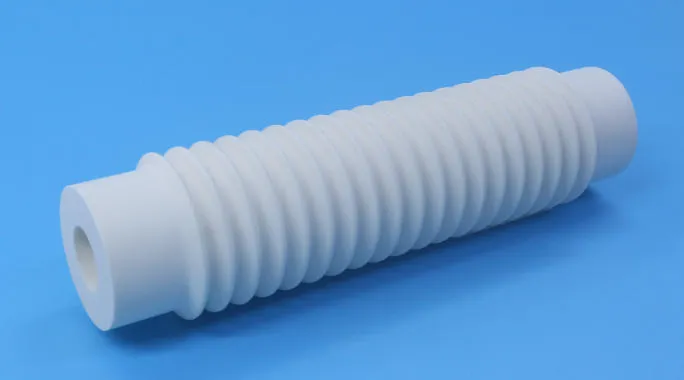Manufacturing alumina ceramic threaded sleeves presents a high-tech challenge in ceramic processing and is extremely difficult.

High-purity alumina ceramic threaded sleeve
Manufacturing Difficulty and Process
1. Molding Difficulty
-
Direct Molding: Threads are formed directly onto a green body (unsintered ceramic body) using precision molds (such as injection molding or dry pressing). This is the most ideal method, but requires extremely high mold precision.
-
Post-Processing: Threads are ground onto the sintered, high-hardness ceramic tube using diamond grinding tools. This is the most common but costly method, with low efficiency and a high risk of chipping.
2. Sintering Shrinkage Control:
Alumina ceramics experience linear shrinkage (approximately 15%-20%) during high-temperature sintering. Extremely precise calculation and design of the body dimensions are required to ensure that the post-sintering thread dimensions (such as pitch and thread angle) meet design requirements.
3. Brittleness:
The brittle nature of ceramics makes the threads extremely fragile. During the screwing process, even the slightest misalignment or excessive force can easily cause thread chipping, rendering the entire component scrapped.
Advantages and Disadvantages
Advantages:
1. Exceptional wear life
2. Excellent corrosion and high-temperature resistance
3. High insulation and non-magnetic properties
4. Prevents thread galling (at high temperatures)
5. High purity and contamination-free
Disadvantages:
1. Extremely fragile, requiring extreme care for installation, prone to thread chipping
2. Extremely high manufacturing cost (low yield, difficult processing)
3. Unable to withstand bending or tensile stress
4. Limited thread sizes, typically metric or specific fine pitch threads
5. Not suitable for applications subject to severe vibration or impact
This material should only be considered when metal, plastic, or other materials do not meet the wear, corrosion, high-temperature, or purity requirements.
The complete thread size (e.g., Mxx x 1.5) must be provided and confirmed to match the mating component exactly. Even the slightest deviation can result in damage. After installation, the piping system must be supported to ensure that the ceramic threaded sleeve is not subjected to any pipe weight, bending stress, or vibration.
Alumina ceramic threaded sleeves are specialized components designed for extreme working conditions, characterized by high performance, high cost, and high fragility. They are not general-purpose components but rather customized solutions for specific industries such as
semiconductors, photovoltaics, and high-end instrumentation.

